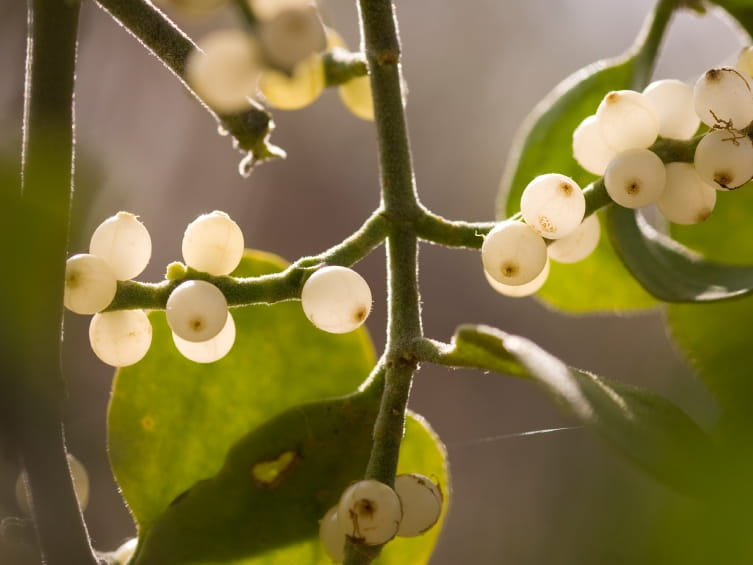Is mistletoe poisonous?

The Bottom Line
Until recent studies were published, the American mistletoe genus, Phoradendron, was widely considered to be extremely poisonous. Swallowing American mistletoe can cause symptoms such as gastrointestinal upset but is not likely to cause serious poisoning if small amounts are unintentionally swallowed.

The Full Story
There are two types of evergreen shrubs with the common name mistletoe: American mistletoe (Phoradendron serotinum) and European mistletoe (Viscum album). Abundant literature and folklore describe the European variety’s herbal, mythical, and medicinal history. Poisonings and deaths have been reported from ingestion of European mistletoe. American mistletoe’s toxic reputation is probably guilt by association because it has the same common name as its European relative.
How poisonous is ingestion of American mistletoe? One study examined the outcomes of 1754 American mistletoe exposures. The overwhelming majority of exposures occurred during the Christmas season when American mistletoe is used decoratively. Children accounted for 92% of these cases, and 96% of all exposures were by swallowing. The vast majority of patients had no symptoms and there were no fatalities, including the 72 people who swallowed mistletoe on purpose.
Another study described 92 American mistletoe exposures (mostly very young children) reported to three poison control centers. Ingestions of up to 20 berries and five leaves were reported. In cases where five or more berries were consumed, none of the patients had symptoms. Three of the 11 patients who swallowed 1-5 leaves developed gastrointestinal upset. One child had a seizure, but it could not be clearly connected to mistletoe. The study concluded that symptoms are uncommon even in large ingestions of American mistletoe.
It appears that American Phoradendron mistletoe is less toxic than the European species Viscum album. The literature on the European variety includes reports of serious poisonings and deaths, usually due to excessive concentrated herbal use such as brewing mistletoe in tea. V. album is not native to or sold in the US, but it could be privately imported.
American mistletoe doesn’t deserve its highly toxic reputation. According to ancient myth, anyone kissed under mistletoe would be blessed by love. So enjoy the “kissing ball” this holiday season but, as with any plant, keep it out of reach of curious children and pets!
If you think someone might have swallowed mistletoe, call Poison Control right away at 1-800-222-1222 or use the webPOISONCONTROL® tool for guidance online.
Mary Elizabeth May, RN, BA, MPH
Certified Specialist in Poison Information
Poisoned?
Call 1-800-222-1222 or
Prevention Tips
- Assign at least one adult to supervise children at holiday gatherings.
- Teach your children never to put any part of a plant in their mouths.
- To prevent small children or pets from eating mistletoe berries or leaves that fall to the ground, consider encasing the plant in netting.
- Consider using artificial mistletoe.
This Really Happened
Case 1. Some decorative American mistletoe was still hanging in a home in February. As it was taken down, dried leaves fell to the floor. The parents of a 9-month-old boy thought they had gathered up all the leaves but later found a mistletoe leaf in the child’s mouth. His mother called Poison Control and was advised to give him something to drink and watch for gastrointestinal upset. When Poison Control followed up 6 hours later, the boy was fine.
Case 2. A family decorated a holiday dessert with European mistletoe leaves and berries grown on their US property. A 3-year-old boy ate 1-2 berries and leaves but didn't have any symptoms. His father, who witnessed the event, called Poison Control. Poison Control recommended giving a snack and something to drink and washing the child's hands. Poison Control also instructed the father to watch the child for vomiting, confusion and drowsiness over the next several hours. When Poison Control checked back by phone 4 hours later and again the next day, the father reported the child was fine. Mistletoe should not be used to decorate food!
For More Information
References
Courtemanche J, Peterson, RG. Beware the mistletoe. CMAJ. 2006;12:1523-4.
Evens ZN, Stellpflug SJ. Holiday plants with toxic misconceptions. West J Emerg Med. 2012;6:538-42.
Hall AH, Spoerke DG, Rumack BH. Assessing mistletoe toxicity. Ann Emerg Med.1986;11:1320-3.
Krenzelok EP, Jacobsen TD, Aronis J. American mistletoe exposures. Am J Emerg Med. 1997;15:516-20.
Poisoned?
Call 1-800-222-1222 or
Prevention Tips
- Assign at least one adult to supervise children at holiday gatherings.
- Teach your children never to put any part of a plant in their mouths.
- To prevent small children or pets from eating mistletoe berries or leaves that fall to the ground, consider encasing the plant in netting.
- Consider using artificial mistletoe.
This Really Happened
Case 1. Some decorative American mistletoe was still hanging in a home in February. As it was taken down, dried leaves fell to the floor. The parents of a 9-month-old boy thought they had gathered up all the leaves but later found a mistletoe leaf in the child’s mouth. His mother called Poison Control and was advised to give him something to drink and watch for gastrointestinal upset. When Poison Control followed up 6 hours later, the boy was fine.
Case 2. A family decorated a holiday dessert with European mistletoe leaves and berries grown on their US property. A 3-year-old boy ate 1-2 berries and leaves but didn't have any symptoms. His father, who witnessed the event, called Poison Control. Poison Control recommended giving a snack and something to drink and washing the child's hands. Poison Control also instructed the father to watch the child for vomiting, confusion and drowsiness over the next several hours. When Poison Control checked back by phone 4 hours later and again the next day, the father reported the child was fine. Mistletoe should not be used to decorate food!
